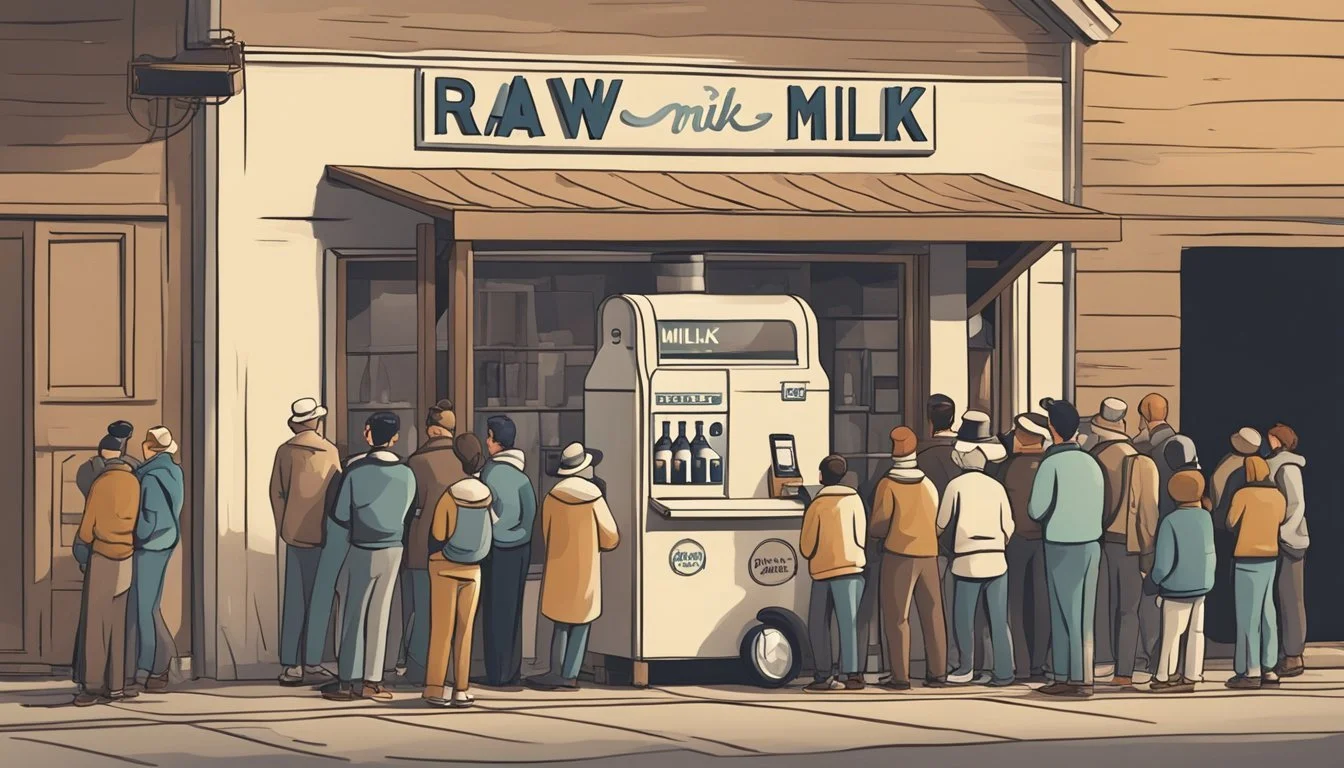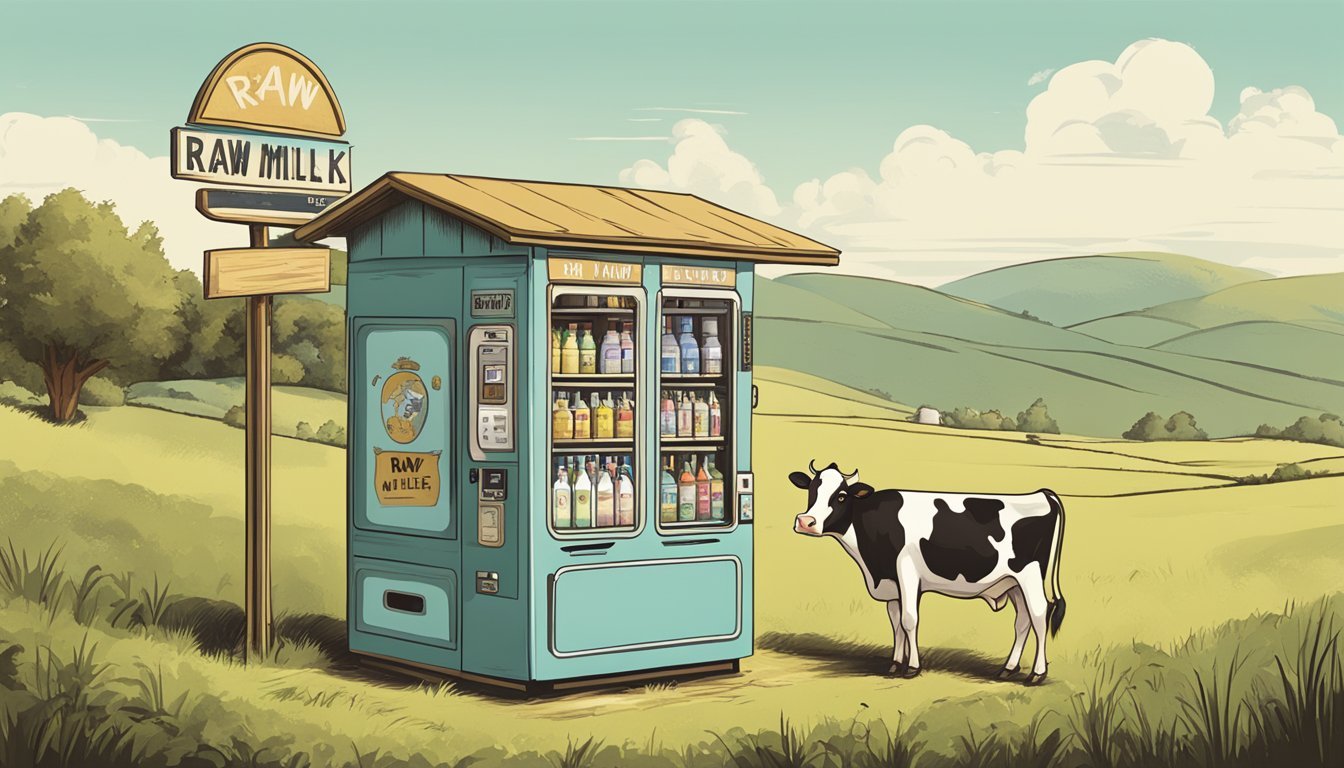The Revival of Raw Milk Vending Machines in Europe
Embracing Traditional Dairy Trends Globally
The revival of raw milk vending machines in Europe reflects a growing trend that prioritizes both consumer desire for fresh, unprocessed products and support for local farmers. These machines offer a direct farm-to-table distribution channel that is increasingly popular among European consumers. In Italy alone, there are approximately 1,300 raw milk vending machines, which are part of a broader network of these machines across the continent including countries like France, Croatia, Switzerland, Austria, and the Netherlands.
The presence of these machines throughout Europe is not new, but their acceptance and popularity have grown, showcasing a shift towards greater acceptance of raw milk consumption despite past health concerns and regulation. This upswing in interest also coincides with an increased availability of raw milk vending machines, making raw milk more accessible than ever before.
Expansion beyond Europe is also evident, with raw milk machines making appearances in India and other parts of Asia. The appeal of these machines lies in their ability to provide fresh milk with minimal processing, while also highlighting an emphasis on sustainability and localism in food consumption practices. As they become more widespread, raw milk vending machines are set to redefine market trends in dairy consumption, especially as markets in Europe are projected to increase the value of these machines significantly by 2024.
The revival of raw milk vending machines in Europe marks a significant milestone in the ongoing raw milk renaissance and the collective efforts of raw milk movement advocacy. These vending machines not only symbolize convenience but also represent a promising outlook for the future of raw milk, providing consumers with direct access to wholesome dairy products.
The availability of raw milk from vending machines also underscores the potential to support raw milk immune systems due to its natural and unprocessed state. Additionally, clear and informative raw milk labels on these vending machine products empower consumers to make informed choices about the dairy they consume.
Furthermore, the inclusion of raw milk probiotics in these products further enhances their appeal, aligning with the principles of promoting holistic well-being and nourishment. The resurgence of raw milk vending machines in Europe reflects a growing appreciation for traditional, unprocessed foods and offers a glimpse into a future where access to natural, nutrient-rich dairy products is readily available, contributing to a thriving and sustainable food ecosystem.
Historical Context of Raw Milk
Raw milk has a storied past, intertwining with the cultural and dietary practices of various European countries. It is the unprocessed, unpasteurized milk obtained directly from dairy cows. This form of milk was historically the norm, consumed for its freshness and natural taste.
Europe's history with raw milk is deeply rooted. Some European consumers prefer raw milk for its perceived health benefits and richer taste as compared to pasteurized milk, which undergoes heat treatment to kill bacteria. Raw milk advocates, such as the Campaign for Real Milk and the Weston A. Price Foundation, argue that it contains beneficial enzymes and nutrients that pasteurization destroys.
Notable for its royal endorsements, raw milk was the choice of British aristocracy well into the 20th century. Queen Elizabeth herself was known to favor raw milk, reinforcing the beverage's prestige. The preference for its taste and nutritive qualities made raw milk a staple in European diets.
As safety became a concern, many countries imposed regulations on raw milk sales, leading to a decline in consumption. However, a revival has been witnessed as raw milk vending machines have started to emerge across the continent.
European Countries with Raw Milk Vending Machines France Italy Croatia Switzerland Austria The Netherlands
In summary, raw milk's presence in Europe's dietary history is significant, marked by cultural endorsements and a recent resurgence through innovative vending solutions, despite the ongoing debates concerning its safety.
Modern Revival of Raw Milk Vending Machines
The resurgence of raw milk vending machines across Europe signifies a growing consumer interest in accessing fresh, unpasteurized dairy directly from farmers. These machines have become a symbol of the direct-to-consumer movement, offering a convenient supply of raw milk.
Pioneering Countries
Italy has been at the forefront of this revival, boasting approximately 1,300 vending machines that provide local communities with access to fresh milk. The distribution of these machines is supported by small family farms, highlighting a commitment to traditional dairy farming methods and local economies.
In France and Austria, these dispensers have similarly gained popularity, facilitating the availability of unpasteurized milk to the public. Slovenia, known for its rich dairy culture, also hosts raw milk vending machines, aligning with its citizens' preference for fresh and natural dairy products.
Expansion into New Territories
The concept of raw milk vending machines is not confined to these pioneers; it's an expanding movement. New territories in Europe and beyond are exploring the potential benefits of incorporating these vending machines into their local communities.
The adoption of automated raw milk sales has grown in regions where regulations allow, and consumer demand aligns with an appetite for fresh, less processed food choices. As such, the presence of raw milk vending machines is expected to increase in areas that support agricultural transparency and wish to foster a closer connection between consumers and their food sources.
Regulation and Legal Landscape
The expansion of raw milk vending machines across Europe is influenced by diverse regulations and legal frameworks specific to each country. These regulatory environments dictate the operation and proliferations of these vending machines.
European Guidelines
European Union (EU) regulations establish broad standards for the production and sale of raw milk to ensure consumer health and safety. These guidelines enable member states to implement more detailed legislation. While the EU provides a framework for raw milk distribution, it leaves room for member states to adapt rules to their local contexts.
Country-Specific Regulations
Each European country applies its regulation, reflecting their local dairy practices and public health policies. Notably:
The Netherlands and Ireland permit the sale of raw milk but have stringent regulation to safeguard public health.
Croatia, Switzerland, and parts of Italy have a more liberal approach, allowing easier access to raw milk vending machines.
The United Kingdom enforces regulations that are specific to England, Scotland, Wales, and Northern Ireland. For example, in England, raw milk sales are restricted to the farm where it is produced, and strict hygiene criteria must be met.
These varying regulations showcase the individual approaches taken by European countries in balancing the demand for raw milk with the need to protect consumers.
Health Aspects
When discussing the health aspects of raw milk vending machines, one must address both the potential nutritional benefits and the associated public health concerns.
Nutritional Benefits
Raw milk proponents argue that unpasteurized dairy products are richer in certain nutrients compared to their pasteurized counterparts. A range of vitamins such as Vitamin A, C, and E, along with minerals like calcium and phosphorus, can be found in higher concentrations in raw milk. Additionally, raw milk is said to contain beneficial enzymes and probiotics that are destroyed during the pasteurization process. However, scientific consensus on the extent of these benefits varies, and the nutritional advantages must be weighed against potential health risks.
Public Health Concerns
The revival of raw milk vending machines in Europe raises significant public health concerns. Harmful diseases can be transmitted through unpasteurized dairy products if not handled properly. These diseases are often caused by pathogens including, but not limited to, Listeria monocytogenes, Salmonella, E. coli, and Campylobacter. As food safety expert Don Schaffner notes, these harmful diseases can be particularly dangerous to pregnant women, infants, the elderly, and those with weakened immune systems.
Maintaining refrigeration temperatures is critical to slow the growth of these bacteria. Yet, even with strict adherence to temperature controls, the risk is not eliminated. Authorities emphasize the importance of good hygiene practices at farms to minimize contamination, but there is still an inherent risk involved with raw milk consumption that consumers must be aware of. Boiling raw milk before consumption is one recommended method to ensure safety and eliminate pathogenic risks.
The Role of Dairy Farmers
Dairy farmers are pivotal in revitalizing raw milk vending machines across Europe, balancing entrepreneurial spirit with regulatory compliance and consumer demand for fresh, local produce.
Local Farming Initiatives
Many dairy farmers have recognized the opportunity to directly market their milk through vending machines, thereby increasing profit margins and establishing a closer connection with consumers. In Italy, for instance, the proliferation of raw milk vending machines is a testament to their popularity, with farmers at the forefront of this movement. They are responsible for the operation and maintenance of these machines, ensuring a steady supply of fresh raw milk. Notable among them is Marko Bitenc, a Slovenian dairy farmer, who has joined this initiative, thereby supporting the local economic ecosystem and providing consumers with an alternative to supermarket chains.
Challenges and Advantages
Dairy farmers face several challenges in the raw milk vending machine enterprise. Primarily, they must adhere to strict hygiene standards to ensure the safety of their unpasteurized milk. Additionally, they bear the responsibility of maintaining the refrigeration units within the vending machines to keep milk at optimal temperatures.
Despite these challenges, there are clear advantages for dairy farmers. By utilizing vending machines, they can bypass traditional retail markups, offering competitive pricing to consumers and retaining more revenue for farm reinvestment. Moreover, by selling directly, farmers gain invaluable feedback and foster customer loyalty, which can be crucial for the farm's brand and long-term success.
Consumer Trends and Demand
The revival of raw milk vending machines is driven by changing consumer preferences and a growing demand for fresh, non-pasteurized milk products. Shifting behaviors and the appeal of purchasing milk directly from its source have influenced market growth significantly.
Market Growth and Trends
The European market has seen a notable expansion in the adoption of raw milk vending machines, with a compound annual growth rate (CAGR) of 12.5% forecasted between 2016 and 2024. Key factors fueling this growth include:
Consumer Demand: A discernible shift towards fresh and healthy products.
Awareness and Income: Increased consumer awareness about the benefits of raw milk, coupled with rising disposable incomes.
The trend suggests an ongoing consumer shift towards valuing the quality and nutritional benefits of raw milk, directly benefiting the vending machine market.
The Influence of Consumer Advocacy
Consumer advocacy groups, such as the Campaign for Real Milk, have been pivotal in driving awareness and demand. They emphasize the health benefits of raw milk and have been instrumental in influencing consumer preferences.
Campaign Impact: The advocacy efforts have helped to create an informed customer base eager to access raw milk through convenient means like vending machines.
Legislation and Awareness: These campaigns also work towards navigating the complex regulatory landscapes, making it easier for consumers to make informed decisions.
In conclusion, the market for raw milk vending machines is growing, supported by an alliance of consumers and advocacy groups promoting the health advantages of raw milk.
Technological Advancements in Vending Machines
The evolution of milk vending machines encompasses considerable enhancements in functionality and safety features, addressing both consumer convenience and regulatory compliance.
Functionality and Design
Vending machines now exhibit high-capacity storage, capable of holding substantial quantities of milk. These machines can operate with different bottle sizes without the need for additional equipment like spacers or shims. They are designed for ease of use, often featuring user-friendly interfaces that facilitate the selection and purchase process. The machines can accommodate various milk types, including fresh, flavored, and raw milk.
Safety and Refrigeration
The most advanced vending machines come equipped with robust refrigeration systems. These ensure that milk is stored at optimal refrigeration temperatures, critical for maintaining product freshness and safety. The refrigeration units are powerful, usually with at least a 5/8 HP refrigeration unit accompanied by heated triple-pane glass to prevent condensation and maintain a clear view of the products. Safety protocols include pasteurization options or recommendations for heat treatment of raw milk to preserve nutritional quality while eliminating potential pathogens. Some machines even offer built-in microwaving capabilities, which can heat the milk efficiently and safely in under two minutes.
Comparison with Pasteurized Milk
Raw milk and pasteurized milk differ markedly in processing, flavor, and community perception. Pasteurization involves heating milk to a specific temperature for a set period to kill bacteria. This process extends shelf life and ensures a standardized level of safety across the milk supply.
In contrast, raw milk comes directly from the animal without undergoing pasteurization. Proponents argue that raw milk retains a richer, more complex taste profile. They assert that the heating process in pasteurization might alter the flavor, diminishing some of the taste nuances that make raw milk unique.
Flavor Comparison
Raw Milk: Described as richer and creamier.
Pasteurized Milk: Some consumers notice a "cooked" flavor compared to raw milk.
Bacterial Content
Raw Milk: Contains natural bacteria, which can be beneficial or harmful.
Pasteurized Milk: Bacteria are largely eradicated through the heating process.
Consumers should be aware that while raw milk can offer a different taste experience, it carries a risk of bacterial contamination if not handled properly. Regulatory approaches in Europe vary, with some countries embracing the sale of raw milk through vending machines as a nod to tradition and consumer preference, while ensuring safety measures are in place.
Global Perspectives
The recent increase in raw milk vending machines epitomizes a shift toward natural food choices, illuminating differing international attitudes towards raw milk consumption.
Adoption Outside Europe
In various regions outside of Europe, the growth of raw milk vending machines signifies a burgeoning interest in unprocessed dairy products. Consumers in countries such as India have shown a willingness to embrace this innovative distribution channel, connecting directly to the source of fresh milk. Markets in these countries are notably influenced by a rising consumer demand for health-oriented and unadulterated food options.
Contrasting North American Attitudes
North America presents a starkly different view when it comes to raw milk vending machines. Unlike in Europe, regulatory frameworks in the United States and Canada are generally less accommodating of raw milk sales due to safety concerns. This has led to swat-style raids on farms and producers, accompanied by legal pressures including court cases and potential jail time for violators. Publications such as Wake Up World and EcoWatch highlight the contentious debate, echoing the consumer desire for access to raw milk against the backdrop of strict governmental oversight.
Future Outlook and Predictions
The raw milk vending machine market is poised to see substantial growth, underpinned by increasing consumer demand for fresh and local food products. However, the market faces challenges related to regulatory hurdles and public health concerns.
Potential for Growth
Market Expansion: With a projected CAGR of 5.5% from 2022 to 2030, the global raw milk vending machine market is expected to expand significantly. The driving forces include rising disposable incomes and greater consumer awareness about the benefits of raw milk.
Consumer Preferences: Shifts towards transparency and direct farm-to-consumer relationships are shaping the industry, as people increasingly prefer sustainable and locally sourced products.
Challenges to Overcome
Regulations: The sale of raw milk via vending machines is subject to strict regulation in many regions. Providers must navigate a complex legal landscape that varies from country to country.
Public Health Concerns: While there's a market for unpasteurized milk, concerns over food safety and the risks associated with consumption of raw milk pose significant challenges.
Consumer Safety: To address these concerns, vendors must ensure rigorous health standards and regular quality checks to maintain trust and avoid public health issues.










